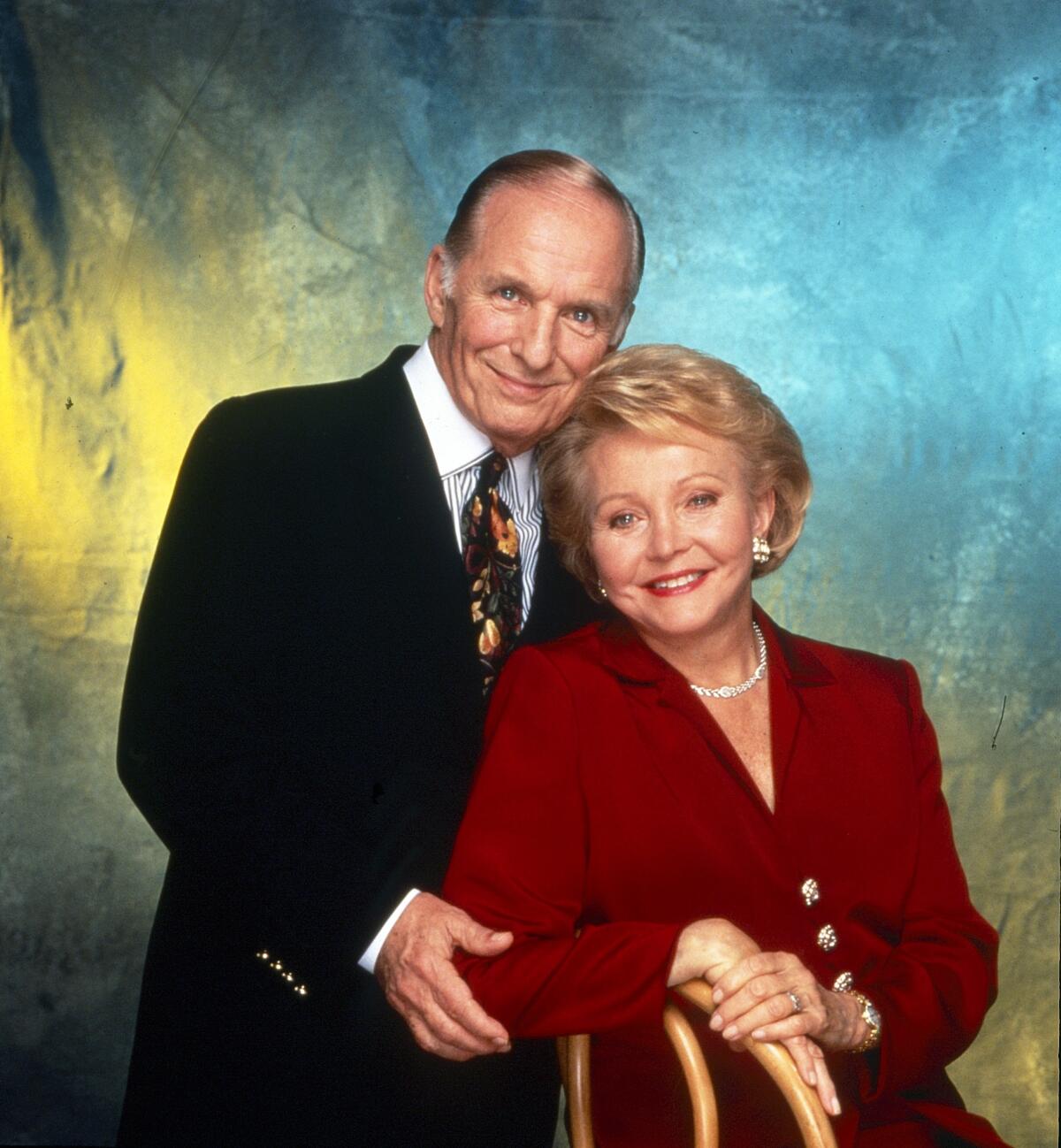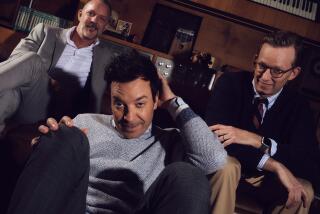4,500 words of dialogue, 250 times a year: How ‘The Young and the Restless’ is made

- Share via
On a recent afternoon, Josh Griffith and Amanda Beall were huddled in an office at CBS Television City, brainstorming a way for two characters on “The Young and the Restless” to embark on a brief affair.
Beall, the show’s co-head writer, had an idea. “Bunker sex,” she said. “It’s tried and true.”
Griffith, the head writer and executive producer, nodded in agreement. “It has to be something where they both realize it doesn’t have a future.”
The discussion moved on to the pressing matter of which sets they would need to tell this story: in other words, where would this bunker sex take place? At any given time, “Y&R” has about 10 active sets, and only a few have bedrooms, so that characters on the show are unusually prone to copulating on office desks and living-room sectionals.
“We have sofas that fans want to burn because so many people have had sex on them,” said Beall.
Like sands through the hourglass, the soap moved to Peacock recently after 57 years on NBC. Whether fans follow could determine the genre’s fate.
Since “Y&R” debuted on CBS on March 26, 1973 — 50 years ago Sunday — its writers have spent countless hours concocting wild trysts and outlandish plot twists in order to feed the insatiable narrative beast that is a daily soap opera.
Created by soap visionary William J. Bell and his wife, Lee Philip Bell, as a visually lush, sexually candid and socially relevant drama that harnessed the youthful energy of the early ‘70s, “The Young and the Restless” has reigned as daytime’s most-watched drama for 35 years and now stands as one of the last remaining titans of the genre.
For the record:
10:10 a.m. March 23, 2023A previous version of this story referred to the actor who plays Nikki Newman as Melody Scott Thomas. Her name is Melody Thomas Scott.
As other once-iconic soaps have been canceled or sent to streaming networks, “Y&R” has endured, drawing an average of 3.67 million viewers to CBS each day — a larger audience than many series in prime time. Known for its evocative theme music, “Y&R” follows the residents of Genoa City, a fictional Midwestern metropolis. Many of the show’s signature rivalries and romances date back to the 1980s. Most famously, there is ruthless businessman Victor Newman (Eric Braedan), who has spent 40 years marrying, divorcing and remarrying former stripper Nikki Newman (Melody Thomas Scott, the show’s longest-running cast member) and clashing with cosmetics tycoon Jack Abbott (Peter Bergman).
Particularly in an era of bespoke TV shows with eight or 10 episodes a season, churning out more than 250 episodes of “Y&R” every year is a grueling feat of mass production — one that would be impossible without a team of writers well-versed in the mechanics of serial storytelling.
Janice Ferri Esser is the longest-serving writer at “Y&R” and has written more than 1,600 episodes since joining the show in 1989. “That’s the equivalent of writing 800 feature films, and having them produced and aired,” she said in a video chat from her home in the Midwest. (“Less than an hour from the real Genoa City,” she said.)
A devoted soap fan since childhood, Esser fondly recalls racing home after school to catch the last five minutes of “Dark Shadows.” Then, she got sucked into “Y&R” as a college student in the late ‘70s. While working as a copywriter in Chicago, she submitted a spec script to “Y&R,” even sending a uniformed Western Union messenger to Bill Bell’s office to get his attention. The stunt worked, and she was eventually asked to join the writing staff.
As a script writer, Esser is responsible for taking the episode outlines and bringing them to life with dialogue. “It’s where the sparkle comes in,” she said. Since maintaining each character’s unique voice is crucial, she often acts out scenes for her cats. “Sometimes I make myself cry. That’s how I know it’s good.”
Despite dramatic shifts in the TV industry, the assembly-line process of writing soap operas, including “Y&R,” has largely remained the same for decades. The head writer comes up with the major arcs that the show will follow over the course of several months, then divides those arcs into weekly plot summaries, or “thrusts.” Using these thrusts, a team known as breakdown writers creates detailed episode outlines, including act breaks and scene descriptions. Finally, these outlines go to the script writers, who write the dialogue and submit their drafts for editing and approval. Within weeks, the episodes are in production.

Like many daytime writers, Esser has always worked remotely, submitting scripts via Fedex, fax and — eventually — email. “The voice of ‘The Young and the Restless’ is very much the voice of regular people in the Midwest and I didn’t want to come to Hollywood and and lose that about myself,” she said.
As technology has advanced, the pace of the work has accelerated. These days, she has about a week to turn in a script consisting of a two-part prologue, six acts, and about 4500 words of dialogue. Then it’s on to the next one.
Esser has helped shape some of the socially conscious narratives “Y&R” is known for, including storylines about AIDS and domestic violence. She also wrote what turned out to be the last scene Jeanne Cooper filmed before her death, a poignant moment in which her character, the formidable Katherine Chancellor, says goodnight to her longtime rival, Jill Abbott, and ascends the stairs.
But as someone who still considers herself a “Y&R” fangirl, Esser also knows she’s there to serve a larger vision — and is happy to do so. “This is not the business to be in if you want to be a novelist,” said Esser, who has also written for “Y&R’s” sister series, “The Bold and the Beautiful.” “You have to sublimate your own ego to some extent.”
It’s essential to “surround yourself with the strongest, fastest writers that you can,” said Griffith, who was tapped as head writer at “Y&R” in late 2018. “It’s not just creativity, it’s endurance that you need. Over the years, we’ve had people from the movies and primetime TV. And they’re brilliant writers, but they don’t have that muscle.”
Griffith isn’t afraid to lean on stock melodrama — the long-lost twins and characters who return from the dead — because, he said, “If you’re true to the characters and really play the emotional levels of what it means to them, then it transcends the soap tropes.” The writers at “Y&R” are sensitive to how viewers respond to storylines, and social media has sped up the feedback loop between soap fans and the people who create them. “You used to wait weeks before people would write their letters telling you how much they hate what you’re doing,” Griffith said. “Now you can find out by the end of the day.”
Anytime Griffith or his writers have questions about whether a plot contradicts something that occurred in the past — which happens a lot on a show that has been on the air since Richard Nixon was president — they consult the continuity department, who can tell them, for example, if the death of Diane Jenkins could possibly have been staged. (Turns out, it could; she returned to the show last year, a decade after her presumed death).
Griffith began his daytime career on NBC’s “Santa Barbara” in the 1980s, and later moved on to “One Life to Live” and “Days of Our Lives.” He still finds the creative freedom of writing for soaps exhilarating. “This is the greatest medium that there is. There’s no limit to what you can do storytelling-wise,” he said.
But the creative model that has fueled “Y&R” for so long appears to be in peril. In February, the Wrap reported that Griffith had terminated the show’s entire breakdown staff and would absorb the work himself. Sources close to the production but not authorized to speak publicly indicated that four out of five breakdown writers were let go. The news sparked outrage from impassioned “Y&R” fans on social media. Many predicted the imminent demise of their beloved soap opera as a result of this downsizing, which was implemented months before a possible strike by the Writers Guild of America.
Sony Pictures Television, which produces the show, declined to comment on the staffing changes, but Griffith defended the action to The Times. “It was a creative decision that we felt would streamline the process and give us more efficiency, given the detailed thrust and layout we were already doing,” he said.
The long-term impact of this overhaul remains to be seen. For now, at least, the show is in celebratory mode. In episodes beginning Thursday, the people of Genoa City will gather for a bicentennial gala that happens to coincide with “Y&R’s” 50th anniversary. Viewers can expect visits by returning characters, and dramatic developments in several percolating storylines.
The goal, as always, is “maintaining a level of dramatic storytelling consistent with what Bill Bell put in place 50 years ago,” Griffith said, “and at the same time, staying relevant.”
‘The Young and the Restless’
Where: CBS
When: 11:30 a.m. weekdays
Streaming: Parmount+
Rating: TV-14 (may be unsuitable for children under the age of 14 with an advisory for suggestive dialogue)
More to Read
The complete guide to home viewing
Get Screen Gab for everything about the TV shows and streaming movies everyone’s talking about.
You may occasionally receive promotional content from the Los Angeles Times.







